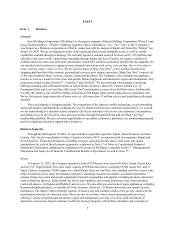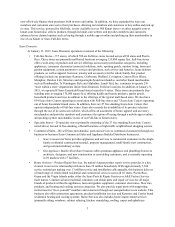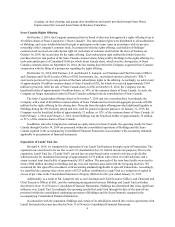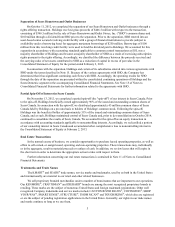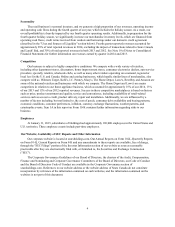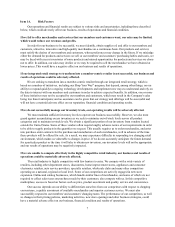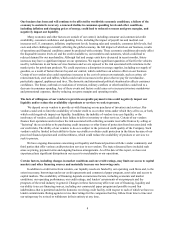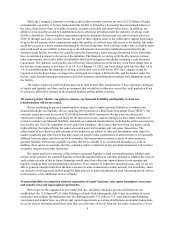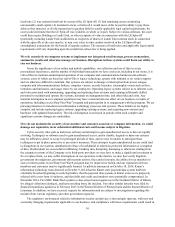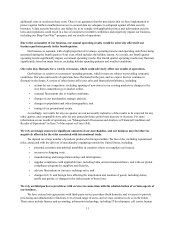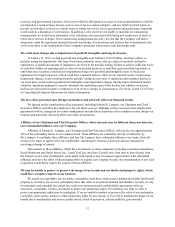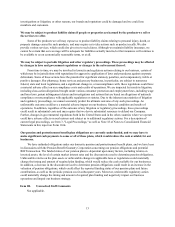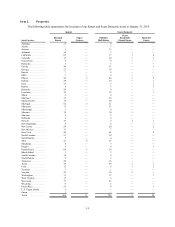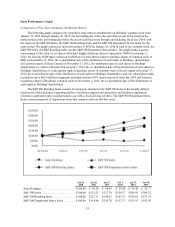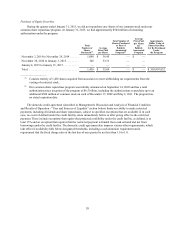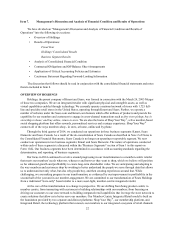Sears 2014 Annual Report Download - page 12
Download and view the complete annual report
Please find page 12 of the 2014 Sears annual report below. You can navigate through the pages in the report by either clicking on the pages listed below, or by using the keyword search tool below to find specific information within the annual report.12
resources and procurement functions. Services provided by third parties as a part of outsourcing initiatives could be
interrupted as a result of many factors, such as acts of God or contract disputes, and any failure by third parties to
provide us with these services on a timely basis or within our service level expectations and performance standards
could result in a disruption of our business. In addition, to the extent we are unable to maintain our outsourcing
arrangements; we would incur substantial costs, including costs associated with hiring new employees, in order to
return these services in-house. These outsourcing arrangements also carry the risk that the Company will fail to
adequately retain the significant internal historical knowledge of our business and systems that is transferred to the
service providers as the employment of the Company's personnel who possess such knowledge ends.
We could incur charges due to impairment of goodwill, intangible and long-lived assets.
At January 31, 2015, we had goodwill and intangible asset balances of $2.4 billion, which are subject to
periodic testing for impairment. Our long-lived assets, primarily stores, also are subject to periodic testing for
impairment. A significant amount of judgment is involved in the periodic testing. Failure to achieve sufficient levels
of cash flow within our reporting unit, or sales of our branded products or cash flow generated from operations at
individual store locations could result in impairment charges for goodwill and intangible assets or fixed asset
impairment for long-lived assets, which could have a material adverse effect on our reported results of operations.
Impairment charges, if any, resulting from the periodic testing are non-cash. A significant and sustained decline in
our stock price could result in goodwill and intangible asset impairment charges. During times of financial market
volatility, significant judgment is used to determine the underlying cause of the decline and whether stock price
declines are short-term in nature or indicative of an event or change in circumstances. See Notes 12 and 13 of Notes
to Consolidated Financial Statements for further information.
The loss of key personnel may disrupt our business and adversely affect our financial results.
We depend on the contributions of key personnel, including Edward S. Lampert, our Chairman and Chief
Executive Officer, and other key employees, for our future success. Although certain executives have employment
agreements with us, changes in our senior management and any future departures of key employees may disrupt our
business and materially adversely affect our results of operations.
Affiliates of our Chairman and Chief Executive Officer, whose interests may be different than your interests,
exert substantial influence over our Company.
Affiliates of Edward S. Lampert, our Chairman and Chief Executive Officer, collectively own approximately
49% of the outstanding shares of our common stock. These affiliates are controlled, directly or indirectly, by
Mr. Lampert. Accordingly, these affiliates, and thus Mr. Lampert, have substantial influence over many, if not all,
actions to be taken or approved by our stockholders, including the election of directors and any transactions
involving a change of control.
The interests of these affiliates, which have investments in other companies, including our former subsidiaries,
Sears Hometown and Outlet Stores, Inc., Lands' End, Inc. and Sears Canada, may from time to time diverge from
the interests of our other stockholders, particularly with regard to new investment opportunities. This substantial
influence may have the effect of discouraging offers to acquire our Company because the consummation of any such
acquisition would likely require the consent of these affiliates.
We may be unable to protect or preserve the image of our brands and our intellectual property rights, which
could have a negative impact on our business.
We regard our copyrights, service marks, trademarks, trade dress, trade secrets, patents and similar intellectual
property as critical to our success, particularly those that relate to our private branded merchandise. As such, we rely
on trademark and copyright law, patent law, trade secret protection and confidentiality agreements with our
associates, consultants, vendors, and others to protect our proprietary rights. Nevertheless, the steps we take to
protect our proprietary rights may be inadequate. If we are unable to protect or preserve the value of our trademarks,
copyrights, trade secrets, patents or other proprietary rights for any reason, or if we fail to maintain the image of our
brands due to merchandise and service quality issues, actual or perceived, adverse publicity, governmental


